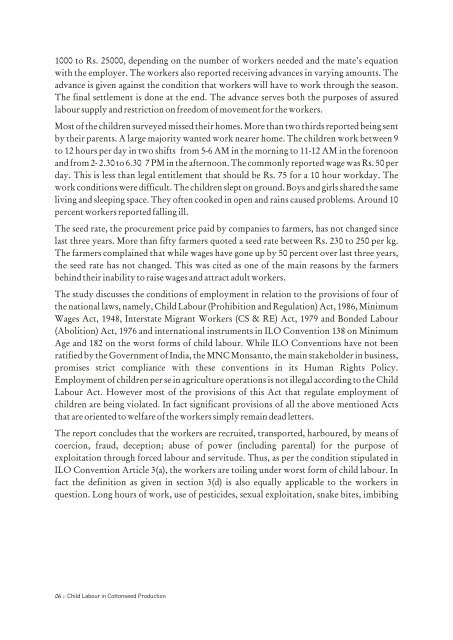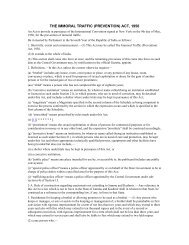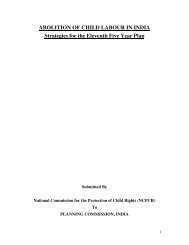Child Labour in Cottonseed Production by Ashok Khandelwal
Child Labour in Cottonseed Production by Ashok Khandelwal
Child Labour in Cottonseed Production by Ashok Khandelwal
You also want an ePaper? Increase the reach of your titles
YUMPU automatically turns print PDFs into web optimized ePapers that Google loves.
1000 to Rs. 25000, depend<strong>in</strong>g on the number of workers needed and the mate's equation<br />
with the employer. The workers also reported receiv<strong>in</strong>g advances <strong>in</strong> vary<strong>in</strong>g amounts. The<br />
advance is given aga<strong>in</strong>st the condition that workers will have to work through the season.<br />
The f<strong>in</strong>al settlement is done at the end. The advance serves both the purposes of assured<br />
labour supply and restriction on freedom of movement for the workers.<br />
Most of the children surveyed missed their homes. More than two thirds reported be<strong>in</strong>g sent<br />
<strong>by</strong> their parents. A large majority wanted work nearer home. The children work between 9<br />
to 12 hours per day <strong>in</strong> two shifts from 5-6 AM <strong>in</strong> the morn<strong>in</strong>g to 11-12 AM <strong>in</strong> the forenoon<br />
and from 2- 2.30 to 6.30 7 PM <strong>in</strong> the afternoon. The commonly reported wage was Rs. 50 per<br />
day. This is less than legal entitlement that should be Rs. 75 for a 10 hour workday. The<br />
work conditions were difficult. The children slept on ground. Boys and girls shared the same<br />
liv<strong>in</strong>g and sleep<strong>in</strong>g space. They often cooked <strong>in</strong> open and ra<strong>in</strong>s caused problems. Around 10<br />
percent workers reported fall<strong>in</strong>g ill.<br />
The seed rate, the procurement price paid <strong>by</strong> companies to farmers, has not changed s<strong>in</strong>ce<br />
last three years. More than fifty farmers quoted a seed rate between Rs. 230 to 250 per kg.<br />
The farmers compla<strong>in</strong>ed that while wages have gone up <strong>by</strong> 50 percent over last three years,<br />
the seed rate has not changed. This was cited as one of the ma<strong>in</strong> reasons <strong>by</strong> the farmers<br />
beh<strong>in</strong>d their <strong>in</strong>ability to raise wages and attract adult workers.<br />
The study discusses the conditions of employment <strong>in</strong> relation to the provisions of four of<br />
the national laws, namely, <strong>Child</strong> <strong>Labour</strong> (Prohibition and Regulation) Act, 1986, M<strong>in</strong>imum<br />
Wages Act, 1948, Interstate Migrant Workers (CS & RE) Act, 1979 and Bonded <strong>Labour</strong><br />
(Abolition) Act, 1976 and <strong>in</strong>ternational <strong>in</strong>struments <strong>in</strong> ILO Convention 138 on M<strong>in</strong>imum<br />
Age and 182 on the worst forms of child labour. While ILO Conventions have not been<br />
ratified <strong>by</strong> the Government of India, the MNC Monsanto, the ma<strong>in</strong> stakeholder <strong>in</strong> bus<strong>in</strong>ess,<br />
promises strict compliance with these conventions <strong>in</strong> its Human Rights Policy.<br />
Employment of children per se <strong>in</strong> agriculture operations is not illegal accord<strong>in</strong>g to the <strong>Child</strong><br />
<strong>Labour</strong> Act. However most of the provisions of this Act that regulate employment of<br />
children are be<strong>in</strong>g violated. In fact significant provisions of all the above mentioned Acts<br />
that are oriented to welfare of the workers simply rema<strong>in</strong> dead letters.<br />
The report concludes that the workers are recruited, transported, harboured, <strong>by</strong> means of<br />
coercion, fraud, deception; abuse of power (<strong>in</strong>clud<strong>in</strong>g parental) for the purpose of<br />
exploitation through forced labour and servitude. Thus, as per the condition stipulated <strong>in</strong><br />
ILO Convention Article 3(a), the workers are toil<strong>in</strong>g under worst form of child labour. In<br />
fact the def<strong>in</strong>ition as given <strong>in</strong> section 3(d) is also equally applicable to the workers <strong>in</strong><br />
question. Long hours of work, use of pesticides, sexual exploitation, snake bites, imbib<strong>in</strong>g<br />
06 :: <strong>Child</strong> <strong>Labour</strong> <strong>in</strong> <strong>Cottonseed</strong> <strong>Production</strong>





